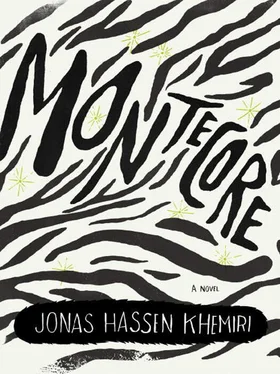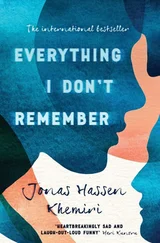“Avedon is really correct in his citation. Pictures have a reality that people lack. It is through my photographs that I know people.”
I never knew what I should answer to such citations. So I kept quiet and shined my nails. Your father continued.
“The question is which studio name will tempt Swedes the most. I mean … I will never compromise about my talent. But the name of the studio must be safe and simultaneously tempting. It should feel curious but also experienced …”
The quantity of the options was many. They wandered between “Pernilla Khemiri’s Studio” (as an appeasing for your mother, who called the studio too risky), “Studio Khemiri Inc.” (professional aura), “Khemiri Art and Photography Studio” (artistic flourish), “Khemiri’s Wild Strawberry Patch” (Bergmanesque and appetizing), “Atelier Palmé” (as an homage to Palme), and “Extremely cheap family portraits!” (as a temptation for the stingy old people at the nearby nursing home).
Suddenly your father levitated to a standing position with a photograph stretched toward the sky like a sweaty Wall Street worker.
“I have it!”
The motif of the photograph was a deliciously beautiful black-haired woman, Brazilian and German in original birth, yellow skirt and blue waist with embroidered flowers … There she stood, Queen Silvia, photographed by your father on a flag-filled stage at Skansen, spring 1983. The stylish, bouclé-haired King Carl Gustaf is visible, blurry in the background. Silvia’s hand is frozen to eternity in its sideways wave, her smile politely distant, and both her eyes precisely half closed like a pupil-exempt demon’s.
“Of course!” shouted your father. “ ‘Studio Silvia!’ That’s what the studio will be called. ‘Studio Silvia, Khemiri’s Artistic Photo Studio.’ ”
That very evening your father projected his plan for how we would invite the Swedish queen to the studio’s opening ceremony. With fresh coffee, wine, colored balloons, and crackling artificial fires, the journalists and art critics would interview the successful man from Tunisia who had left SL and started his own photographic studio.
“ ‘Photographer gets grand visit’ … That’s what the headlines will spell! ‘The queen on a photo visit!’ ‘The queen’s new court photographer.’ That will show those damn idiots …” (my certainty is not convinced whether your father was referring here to your mother’s family, the refusing gallery owners, his ex — SL boss, or the landlord of the store [presumably all of them]).
Equally as much as your mother loved your father, she detested his suggestions for studio names.
“You cannot be serious!” she auctioned on her premier visit to the soon-renovated studio.
“Why not?”
“Ugh … ‘Studio Silvia’? It sounds almost pornographic. Besides, Silvia gives me the willies … She looks like a vampire … Our dear Nazi queen! It’s a very bourgeois photograph, extremely antidemocratic and noncommunistic and imperialistic! Please, localize it in the trash room instead of the display window.”
But your father maintained her faux pas.
“It gives the studio extra-fine class!” he expressed proudly and pointed at the goldish frame he had invested for the Silvia photo. “Besides, it will tempt customers. Young and old. This is my certain conviction.”
Your mother observed your father and, though she wanted to, could not hold her serious front. She attracted her body toward his, bent her back, and let her soft lips nose his neck.
“I get so tired of you,” she whispered in French, but her intonation bore a warmth that spoke of a diagonal opposite. Here I remember that you and I imitated each other. Both of our cheeks were reddened by the kisses that were shared between your parents, and we took our shelter out in the courtyard until the danger had passed.
Your mother’s protests against the studio’s name were both retarded and unmotivated. “Studio Silvia” became the name we wrote on the wooden sign that swung its squeaking sound outside the door. Underneath it said in leaning letters: “Khemiri’s Artistic Photography Studio.” Your father embellished the sign with some mountaintops at the bottom.
Before the opening, your father formulated an elegant letter on the finest stationery with your smiling mother’s assistance. It was addressed to the royal palace. Your father praised Queen Silvia’s cleverness, wisdom, and loveliness, congratulated her choice of new homeland, and invited her majestic form to be present at an official opening ceremony addressed to her honor.
Studio Silvia opened its doors in April 1986. It was a magnificent Saturday. The walls of the foyer presented the best of your father’s photographic Sweden suite. There was the series of snow-frozen day-after vomits in extreme close-up. There were dried leaf poles and piles of empty beer bottles. There were several photos of proper-suit Swedes standing on sunny street corners with the exact same serene expression. There was a black-and-white blur picture of a Volvo Amazon that had crashed a softly bent street sign at Sankt Eriksplan. There were three colored-over levels and the Silvia photo in blowup. Farthest in the corner there was even a photo with your father’s initial favorite motif: a powerfully snowed-over, brown-rusted bike with punctured tires, frosted handlebars, and icicles erected from the seat.
Our preparations had been meticulous. All the Swedish papers had been invited with personal exhibition cards, and neighbors had been informed with leaflets. Swedish houses of publication had been invited because your father wanted to inspire them to do a book about Swedes in the same format as Robert Frank’s The Americans . In Current Photography , under the heading “What’s Happening,” everyone with an interest in photos could look up the page before the last and read: “The photographer Abbas Khemiri exhibits ‘The photo that should have won the Sweden Picture’ at Studio Silvia in Stockholm.” The announcement found its position right between information about an exhibition in honor of Arvika’s seventy-fifth anniversary and the Sven Wingqvist Secondary School’s student exhibition at the Photo House in Gothenburg.
Your father greeted all the guests with wine and coffee in plastic cups. Balloons adorned fluorescent lights, pretzels filled bowls, and your whole family was present, even your grandmother, who greeted me politely, shared me a cigarette, and gave me a very kind impression. Soon the studio was piled with generous laughter and billowing cigarette smoke, flowers and shouts of “hooray,” praisings and hugs. In order to be able to court his guests, Abbas delegated me his compact camera and comically named me “the photographer’s court photographer.” I accelerated myself in order to document all the guests in attendance. In one corner, your mother’s political friends. One could recognize them by their ample lunettes, their antinuclear brooches and beige trench coats. They waved their coat belts and incited politics while they scratched their mustaches (both the men and the women). Near the entrance: the retired ladies from the nursing home who were tempted by the free coffee. They drank with birdishly quick sips, pressed their handbags against their stomachs, and exposed suspicious line-mouths. The hippie friends parked themselves on the floor, men in soft sandals with socks and women in ponchos and newly created nicknames like “Sundawn” or “Light Reflector.” In the other corner, the Aristocats installed their bodies around a table and by habit turned their backs on the rest of the guests: the old ex-boxer Nabil, Mansour with the square portfolio, and Mustafa with the little tinfoil packet whose contents your father directed him to smoke outdoors (after getting himself a little sample).
Читать дальше










